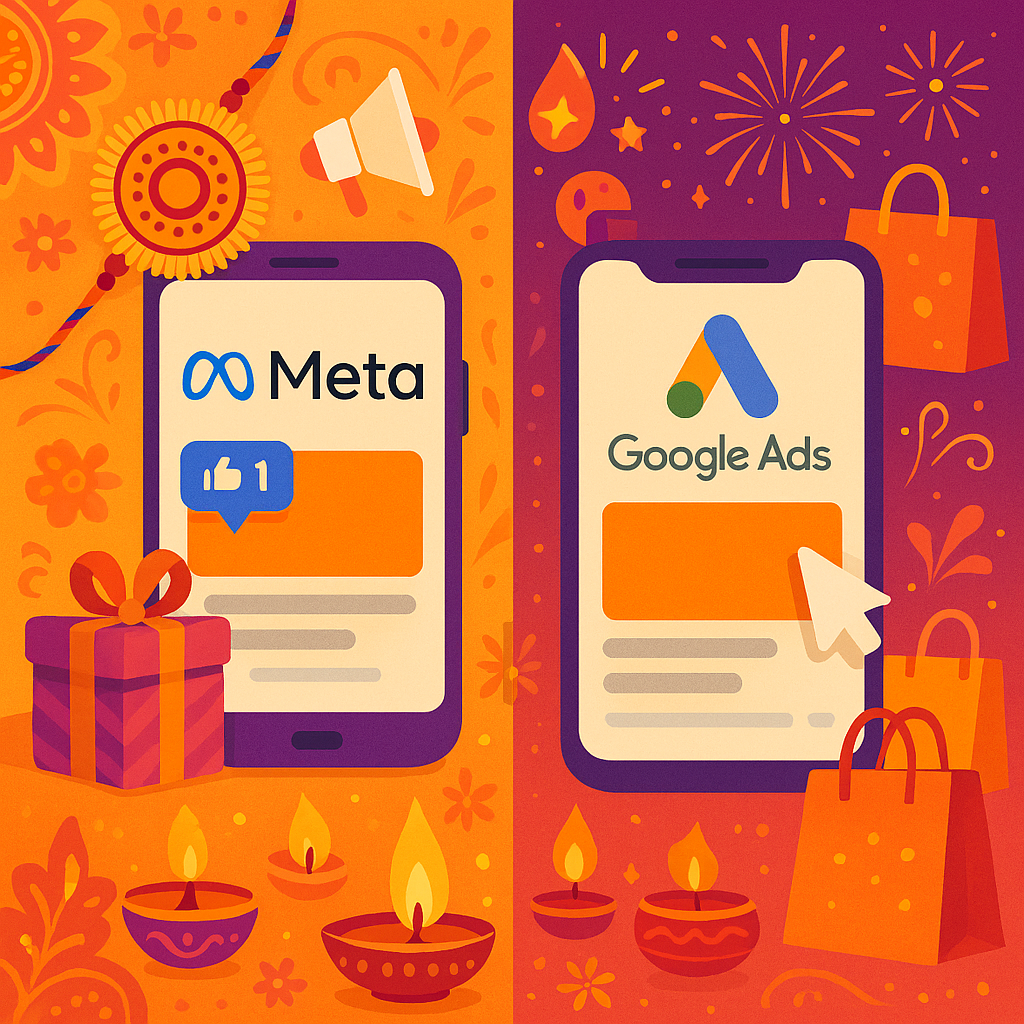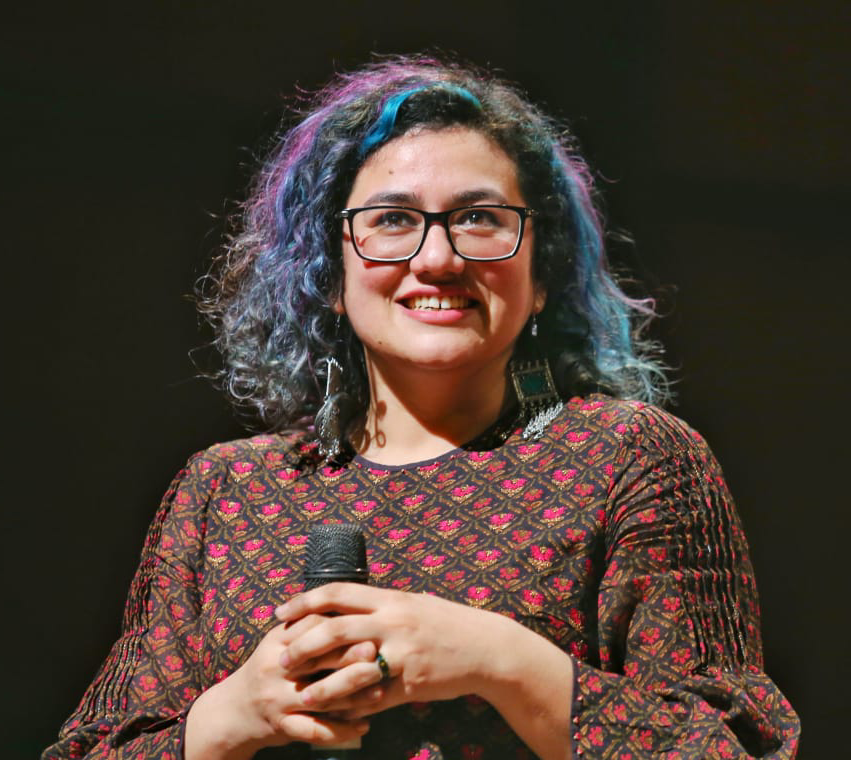
India’s festive season isn’t just a celebration; it’s a shopping marathon. From Raksha Bandhan to Diwali, consumer behaviour undergoes a dramatic transformation. Purchase intent skyrockets and brands have a golden opportunity to tap into emotional triggers and cultural moments.
However, with numerous digital platforms available, how do you determine where to allocate your ad budgets? Should you double down on the storytelling power of Meta Ads (Facebook & Instagram) or capture high-conversion search traffic with Google Ads?
As a seasoned Advertising Agency in Ahmedabad and a full-service Digital Marketing Agency in India, we’ve helped countless brands ride this festive wave. In this blog, we’ll compare Meta vs Google Ads with real brand examples, campaign insights and proven tips, festival by festival.
Table of contents
- Why the indian festive season matters for digital marketing
- Meta vs Google Ads: what’s the difference?
- Festive Marketing Tips: Leveraging Meta and Google Ads
- Choosing the right platform: a strategic approach
- How Brands Celebrated the Festivals
- Conclusion: Make Every Impression Count This Festive Season
- FAQs
Why the Indian Festive Season Matters for Digital Marketing
The Indian festive season, from Raksha Bandhan to Diwali and beyond, is a crucial period for digital marketing due to a unique blend of cultural significance and heightened consumer activity.
Increased spending and purchases: Consumers engage in significant shopping for gifts, upgrades (especially in electronics and fashion) and festive items during this time. This translates to a massive market opportunity, with e-commerce sales soaring and billions of dollars spent annually.
Emotional connection: Festivals evoke strong emotions, allowing brands to forge deeper connections with their audience through culturally relevant campaigns and storytelling. Campaigns that resonate emotionally can drive loyalty beyond the festive period.
Surge in online activity: Consumers actively use digital platforms for research, deals and celebrations. Studies show a significant increase in online searches and social media engagement during this period. Mobile shopping is also dominant, with a large percentage of festive shopping done on smartphones.
Brand differentiation and market share: The festive season presents a crowded market, but it also offers a chance for brands to stand out through creative digital strategies, influencer collaborations and culturally sensitive messaging.
Sales targets and long-term value: For many businesses, a significant portion of annual sales is generated during the festive period, making successful festive campaigns essential for financial growth. These campaigns also offer the chance to build lasting customer relationships.
Meta vs Google Ads: What’s the Difference?
| Platform | Meta Ads | Google Ads |
|---|---|---|
| User Intent | Passive, discovery-based browsing | Active, user searching with purchase intent |
| Targeting | Interests, demographics, behaviour and custom | Keywords, remarketing, custom audiences |
| Best For | Brand storytelling, impulse purchases and awareness | Bottom-funnel conversion, price comparison and urgency |
| Formats | Reels, Stories, Carousels, Lead Forms | Search ads, Shopping ads, YouTube videos, Display banners |
Targeting Capabilities
Meta Ads (Facebook Ads): Excel at interest-based and demographic targeting, allowing businesses to define audiences based on factors like age, location, interests, behaviours (e.g., recent purchasers) and connection to specific pages. This is highly effective for building brand awareness and creating demand among potential customers who might not yet be actively searching for your products or services. Imagine targeting individuals interested in fashion and gifting for a Raksha Bandhan clothing brand or parents with young children for Janmashtami celebrations. Meta allows more niche and specific audiences to be targeted for ad placements.
Google Ads: Focus on intent-based targeting, primarily through keywords and search queries. This means ads are displayed to users actively seeking specific products. Services or information, making it ideal for capturing existing demand and driving conversions from customers closer to making a purchase. Think about a user searching “buy Rakhi online”; Google Ads can place your e-commerce store’s ad directly in their search results.
Ad Formats and Creative Potential
Meta Ads: Offer a vast array of visually rich ad formats, including image ads, video ads, carousel ads and stories, all designed to capture attention within a user’s social feed. This allows for powerful storytelling and showcasing products in an engaging manner. A jewellery brand, for example, could leverage video ads on Meta platforms to showcase their latest festive collection, targeting women aged 25-50 who are interested in luxury goods. Flora Fountain notes that Meta’s visual and interactive formats can present products vibrantly.
Google Ads: Primarily focuses on text ads in search results, along with shopping ads (featuring product images and pricing) and video ads (via YouTube). While less visually driven than Meta, Google Ads prioritises providing relevant information to high-intent users. For example, a home decor brand could use shopping ads to display decorative items for Diwali to users searching for “Diwali home decorations online”.
Cost and Return on Investment (ROI)
Meta Ads: Can often offer a lower cost per click (CPC) or cost per thousand impressions (CPM), making them attractive for campaigns focused on brand awareness and engagement. The ROI, however, might be a longer-term gain, building brand loyalty and awareness over time. In India, Netzens Softech data suggests Meta CPCs are 20-30% cheaper in Tier 2/3 cities.
In fact, during a 2025 India campaign, Google Ads delivered 46% more leads and 32% lower cost per lead than Meta Ads for a leading FMCG brand, making it a powerful tool for brands that prioritise precision and speed over passive awareness.
Festive Marketing Tips: Leveraging Meta and Google Ads
India’s festive season, from Raksha Bandhan to Diwali, is one of the most profitable periods for businesses, with heightened emotions, increased consumer spending and stronger online engagement. During these months, people are not only celebrating traditions but also actively searching for gifts, event services, fashion, home décor and food. This makes festive marketing a unique opportunity for brands to connect emotionally, drive awareness and boost conversions.
To stand out in a crowded digital space, marketers must align their ad strategies with the spirit of each festival while choosing the right platforms. Meta Ads (Facebook & Instagram) are ideal for creating visually engaging, emotional and storytelling-driven content that resonates with users scrolling through their feeds. On the other hand, Google Ads are excellent for reaching high-intent users who are actively searching for festive products, gift ideas or nearby services. The best campaigns strike a balance, using Meta to inspire and Google to convert. Navigating the complexities of festive marketing and optimising campaigns across Meta and Google Ads can be challenging, especially during peak seasons. This is where partnering with an experienced Advertising Agency in Ahmedabad or a leading Digital Marketing Agency in India can make a significant difference.
Choosing the right platform: A strategic approach
The decision between Meta Ads and Google Ads isn’t about choosing one over the other but understanding how they complement each other to create a holistic festive marketing strategy.
For Brand Awareness and Engagement (Top of the Funnel): Meta Ads are often more effective due to their visual nature and interest-based targeting. Use them to introduce new festive collections, tell stories and build an emotional connection with your audience. For example, a new clothing brand launching a festive collection could use Meta Ads to showcase the outfits through engaging video and image carousels, targeting users interested in fashion and festivals.
For Capturing Demand and Conversions (Bottom of the Funnel): Google Ads shines here, as they target users actively searching for your products or services. Use them to capture high-intent buyers ready to make a purchase. For example, a home electronics store could use Google Ads to target users searching for “best LED TV for Diwali”, directing them to a landing page showcasing their latest offers and specifications.
Full-Funnel Strategy: Many businesses find the most success by integrating both platforms. some businesses use Google for first-touch traffic and Meta for remarketing and storytelling. You might use Meta Ads to generate initial interest in a new festive product, then retarget those interested users with Google Search Ads or Display Ads when they are actively searching for similar items.
Making It Work: Where Meta And Google Ads Truly Shine
Festive campaigns aren’t one-size-fits-all. Understanding where and how Meta and Google Ads perform best can help brands unlock their full potential. Here’s a quick breakdown:
Meta Ads: For Visual Impact, Emotional Connection & Discovery
Best Suited for:
- Jewellery brands showcasing festive collections
- Fashion and beauty launches
- FMCG brands creating mass appeal with storytelling
- Awareness campaigns, giveaways, contests
Why it works:
- Platforms like Instagram and Facebook are visual first. This makes them ideal for capturing festive sentiment through videos, carousels, reels and stories.
- Meta’s interest-based targeting allows you to reach audiences who may not be searching for your product, but are highly likely to engage when they see it.
- Great for reaching Tier 2 and Tier 3 audiences with regional creatives and festival-specific content.
Use Meta Ads when:
- You want to inspire, entertain, or emotionally connect.
- You’re launching a new product or festive collection or want viral engagement.
- You’re targeting early-stage discovery or remarketing to existing audiences.
Google Ads: For Search Demand, Urgency & Conversions
Best suited for:
- High-intent searches like ”buy diwali gifts online” or rakhis for brothers under 100”.
- Local store visits (via Google Maps/local ads)
- E-commerce brands with strong festive offers
- FMCG brands pushing fast-moving deals
Why it works:
- Google Ads meet users when they’re actively searching, making them more likely to convert.
- Shopping Ads let you show price, product and ratings upfront, reducing decision time.
- E-commerce brands with strong festive offers
- Ideal for Diwali electronics deals, Rakhi express shipping offers, and search-heavy verticals like beauty and home décor.
Use Google Ads when:
- You want to convert, retarget, or catch in-the-moment demand.
- Your product solves an immediate festive need (e.g., gifts, sweets, outfits).
- You’re competing in a space where search visibility = sales.
Combine Both for Maximum Festive Impact
Think of Meta as the sparkle that catches the eye and Google as the engine that drives action. The best festive campaigns use both platforms in sync:
- Use Meta to create demand, then Google to capture it.
- Use Google for search and shopping ads, then retarget with Meta Reels or Stories.
- Use Meta for brand storytelling and Google to convert window shoppers into buyers.
Conclusion: Make Every Impression Count This Festive Season
From Raksha Bandhan to Diwali, the Indian festive calendar offers unparalleled opportunities for brands to connect with emotionally primed, purchase-ready audiences. But the real magic lies in strategic execution, knowing when, where and how to reach your audience.
While Meta Ads excel at building emotional resonance and visual storytelling, Google Ads shine in moments of active search and high-intent conversions. The most impactful festive marketing plans often blend the two, combining Meta’s creative spark with Google’s performance-driven edge.
Want to build scroll-stopping, click-converting festive campaigns? Partner with an experienced Advertising Agency in Ahmedabad or a trusted Digital Marketing Agency in India to maximise every rupee this season.



